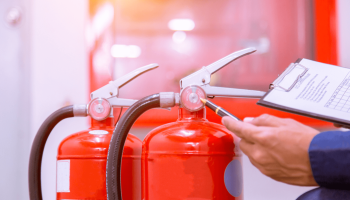Fire Alarm Systems
Providing 24/7 Fire Protection To Your Business
A fire alarm system is a crucial component of fire protection and life safety in buildings. Its primary purpose is to detect the presence of a fire and alert the occupants, allowing them to evacuate safely and facilitating a prompt response from emergency services. Fire alarm systems are designed to
quickly detect and provide early warning of a fire, reducing the risk of injuries, fatalities, and property
damage.
Here are the key components and functions of a typical fire alarm system:
- Fire Detectors: These devices are strategically placed throughout the building and are designed to sense the presence of smoke, heat, or flames. There are different types of fire detectors, including smoke detectors, heat detectors, flame detectors, and multi-sensor detectors. Each type has specific characteristics and applications.
- Control Panel: The control panel serves as the brain of the fire alarm system. It receives signals from the detectors and processes then information to determine if there is a fire or any other abnormal condition. In case of an alarm, the control panel activates the notification devices and may also transmit a signal to a monitoring service or the local fire department.
- Notification Devices: These devices are responsible for alerting the occupants of a building in the event of a fire. Common notification devices include audible alarms (such as horns, sirens, or bells) and visual alarms (such as strobe lights or flashing beacons). The notification devices are strategically located throughout the building to ensure that the alarm can be heard and seen by everyone.
- Manual Call Points: These are manual activation devices that allow individuals to manually initiate a fire alarm if they discover a fire or suspect a fire emergency. Manual call points are typically located near exits or in areas where a fire hazard may be present. When activated, they send a signal to the control panel to initiate the alarm sequence.
- Monitoring and Communication: Advanced fire alarm systems may be connected to a monitoring service or a centralized control room, where trained personnel can receive and respond to alarm signals. This allows for quick emergency response and coordination with fire departments. Some systems can also integrate with other building systems, such as HVAC (heating, ventilation, and air conditioning), to provide additional safety features.
- Power Supply and Backup: Fire alarm systems require a reliable power supply to operate effectively. They are typically connected to the building’ss electrical system and backed up by batteries or an uninterruptible power supply (UPS) to ensure continued operation in the event of a power failure. Fire alarm systems are designed, installed, and maintained in accordance with local fire codes, standards, and regulations. Regular inspections, testing, and maintenance are essential to ensure their proper functioning and compliance with safety requirements.
In summary, a fire alarm system is a critical safety measure that detects and alerts occupants to the presence of a fire, allowing for timely evacuation and prompt response from emergency services. By providing early warning, fire alarm systems play a vital role in protecting lives and minimizing property damage during fire emergencies.

Design

Complete CAD Drawings

Permits

As-Builts

Installation

Inspection

Customization

Smoke Detector Sensitivity Training
Get A Quote

